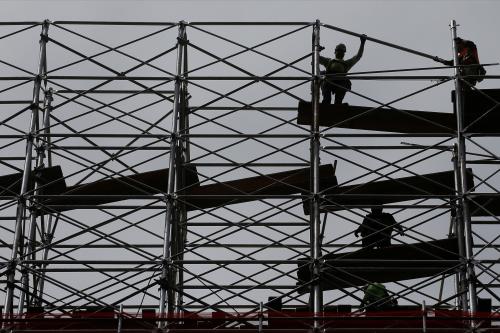The Bureau of Labor Statistics (BLS) employment report released today shows that 156,000 new jobs were added in August. In this blog post, I put forward three alternative projections for job growth in August 2017, each of which was calculated using methodology outlined in my past research. Applying both a more stable seasonal adjustment to the raw data, and accounting for the effects of weather on employment yields 170,000 jobs, 14,000 above the BLS Official number.
Calculating the Alternative Seasonal Adjustment
Monthly job gains and losses can indicate how the economy is doing once they are corrected to account for the pattern the BLS already expects in a process called seasonal adjustment. The approach for this seasonal adjustment that is presently used by the BLS puts very heavy weight on the current and last two years of data in assessing what are the typical patterns for each month.
In my 2013 paper “Unseasonal Seasonals?” I argue that a longer window should be used to estimate seasonal effects. I find that using a different seasonal filter, known as the 3×9 filter, produces better results and more accurate forecasts by emphasizing more years of data. The 3×9 filter spreads weight over the most recent six years in estimating seasonal patterns, which makes them more stable over time than the current BLS seasonal adjustment method.
To produce the Alternative Seasonal Adjustment, I calculate the month-over-month change in total nonfarm payrolls, seasonally adjusted by the 3×9 filter, for the most recent month, which you can see in table below. The corresponding data as published by the BLS are shown for comparison purposes. According to the Alternative Seasonal Adjustment, the economy added 142,000 jobs in August, 14,000 below the official BLS total of 156,000.
Calculating the Seasonal and Weather Adjustment
In addition to seasonal effects, abnormal weather can also affect month-to-month fluctuations in job growth. In my 2015 paper “Weather-Adjusting Economic Data,” Michael Boldin and I implement a statistical methodology for adjusting employment data for the effects of deviations in weather from seasonal norms. This is distinct from seasonal adjustment, which only controls for the normal variation in weather across the year. We use several indicators of weather, including temperature and snowfall.
Temperatures in August were roughly 1°C cooler than the historical average, which lowered employment by 24,000 jobs. This translates to a Seasonal and Weather Adjustment estimate of 180,000 new jobs.
It is important to note that Hurricane Harvey had no discernable effect on the employment data for August. The category 4 hurricane made landfall in Texas on August 26, and proceeded to flood the city of Houston—America’s 4th largest city—for the next several days, causing damage to tens of thousands of homes and forcing many residents to seek shelter. Roads were flooded, and most residents of Houston and the surrounding towns were unable to get to work in the final week of August. However, the establishment survey, which is used to count the number of people employed, was based on data largely collected before the storm. Indeed, the BLS employment release notes that the “establishment survey data collection for this news release was largely completed prior to the storm, and collection rates were within normal ranges nationally and for the affected areas.” Moreover, given the definition of employment in the establishment survey, for the hurricane to affect employment one’s employer would have had to anticipate the hurricane by August 12, which is highly implausible. However, it is likely that the hurricane will affect future jobs numbers, as the economic disruption in the Houston area will be long lasting.
Combining the Alternative Seasonal and Weather Adjustments
My Alternative Seasonal Adjustment shows lower job gains than reported by the BLS, but the Seasonal and Weather Adjustment shows higher job gains. One can indeed do the two adjustments jointly—both adjusting for weather effects and using a longer window. This is shown in the far-right column of the table labeled Combined Alternative Seasonal and Weather Adjustment.
Making both adjustments, the employment change in August was an increase of 170,000 jobs, slightly more than the BLS Official number. The economy has added an average of 175,000 jobs through the first 8 months of 2017, according to the Alternative Seasonal and Weather Adjustment, below last year’s pace of 196,000. Still, job growth appears to be healthy. The lingering effects of Hurricane Harvey on employment remain to be seen.
| Thousands of jobs added | BLS Official | Alternative Seasonal Adjustment[1] | Seasonal and Weather Adjustment[2] | Weather Effect[3] | Combined Alternative Seasonal and Weather Adjustment[4] |
|---|---|---|---|---|---|
| 2017-August | 156 | 142 | 180 | -24 | 170 |
| 2017-July | 189 | 208 | 171 | +18 | 187 |
| 2017-June | 210 | 220 | 211 | -1 | 227 |
| 2017-May | 145 | 130 | 165 | -20 | 147 |
| 2017-April | 207 | 197 | 170 | +37 | 171 |
| 2017-March | 50 | 30 | 113 | -63 | 89 |
| 2017-February | 232 | 252 | 209 | +23 | 222 |
| 2017-January | 216 | 202 | 196 | +20 | 185 |
| 2016-December | 155 | 160 | 157 | -2 | 165 |
| 2016-November | 164 | 179 | 172 | -8 | 173 |
| 2016-October | 124 | 132 | 121 | +3 | 135 |
| 2016-September | 249 | 255 | 263 | -14 | 257 |
| 2016-August | 176 | 150 | 164 | +12 | 153 |
Note: Changes in previous months’ numbers reflect revisions to the underlying data.
[1] Applies a longer window estimate of seasonal effects (see Wright 2013).
[2] Includes seasonal and weather adjustments, where seasonal adjustments are estimated using the BLS window specifications (see Boldin & Wright 2015).
[3] BLS Official number less the Seasonal and Weather Adjustment number.
[4] Includes seasonal and weather adjustments, where seasonal adjustments are estimated using a longer window estimate.
The author did not receive financial support from any firm or person for this article or from any firm or person with a financial or political interest in this article. He is currently not an officer, director, or board member of any organization with an interest in this article.





Commentary
Job growth cools down in August, Hurricane Harvey not a factor
September 1, 2017